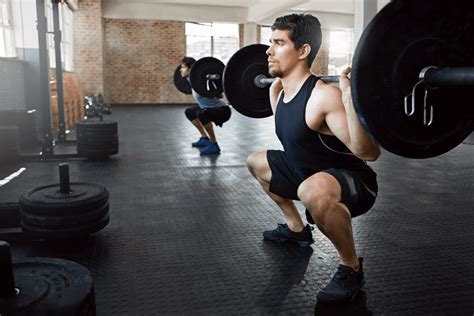Improve Ankle Mobility for Squats

Improving ankle mobility is a crucial aspect of achieving proper form and maximizing the benefits of squats, a fundamental exercise in strength training and athletic development. The ankles play a vital role in the squat movement, as they must be able to dorsiflex (move upwards towards the shin) to allow for the knees to track forward over the toes. Limited ankle mobility can lead to a range of issues, including poor squat form, decreased depth, and increased risk of injury. In this article, we will explore the importance of ankle mobility for squats, discuss the causes of limited ankle mobility, and provide a comprehensive guide on how to improve ankle mobility for squats.
Key Points
- Ankle mobility is essential for proper squat form and depth
- Limited ankle mobility can lead to poor squat form and increased risk of injury
- Tight calf muscles, weak ankle stabilizers, and poor foot mechanics are common causes of limited ankle mobility
- Stretching, mobilization, and strengthening exercises can help improve ankle mobility
- Improving ankle mobility requires a consistent and progressive training approach
Understanding Ankle Mobility and Its Importance for Squats

Ankle mobility refers to the range of motion in the ankle joint, which is essential for various movements, including squats. The ankle joint is a complex structure that consists of multiple bones, ligaments, and tendons, which work together to provide support, stability, and mobility. During a squat, the ankles must be able to dorsiflex to allow for the knees to track forward over the toes, which enables the hips and knees to maintain proper alignment and generate force. Limited ankle mobility can disrupt this movement pattern, leading to poor squat form, decreased depth, and increased risk of injury.
Causes of Limited Ankle Mobility
There are several causes of limited ankle mobility, including tight calf muscles, weak ankle stabilizers, and poor foot mechanics. Tight calf muscles can restrict the range of motion in the ankle joint, making it difficult to dorsiflex. Weak ankle stabilizers, such as the peroneal muscles, can also contribute to limited ankle mobility by failing to provide sufficient support and stability to the ankle joint. Poor foot mechanics, such as overpronation or supination, can also affect ankle mobility by altering the alignment of the foot and ankle during movement.
| Common Causes of Limited Ankle Mobility | Description |
|---|---|
| Tight Calf Muscles | Restrict the range of motion in the ankle joint |
| Weak Ankle Stabilizers | Fail to provide sufficient support and stability to the ankle joint |
| Poor Foot Mechanics | Alter the alignment of the foot and ankle during movement |

Improving Ankle Mobility for Squats

Improving ankle mobility requires a consistent and progressive training approach that includes stretching, mobilization, and strengthening exercises. Stretching exercises, such as calf raises and ankle circles, can help increase the range of motion in the ankle joint. Mobilization exercises, such as ankle mobs and joint capsules, can help improve the flexibility and mobility of the ankle joint. Strengthening exercises, such as single-leg squats and balance exercises, can help improve the strength and stability of the ankle joint.
Stretching Exercises for Ankle Mobility
Stretching exercises are an essential part of improving ankle mobility. The following exercises can help increase the range of motion in the ankle joint:
- Calf raises: Stand on the edge of a step or curb with your heels hanging off the edge. Slowly raise up onto your tiptoes and then lower back down.
- Ankle circles: Sit on the floor with your legs straight out in front of you. Lift your feet off the ground and draw circles with your ankles, starting from small circles and gradually increasing in size.
- Toe walks: Walk on your toes for 10-15 feet, focusing on keeping your heels off the ground.
Mobilization Exercises for Ankle Mobility
Mobilization exercises can help improve the flexibility and mobility of the ankle joint. The following exercises can help:
- Ankle mobs: Use a foam roller or lacrosse ball to roll out the front and back of your ankle, focusing on the areas that feel tight or restricted.
- Joint capsules: Use a resistance band or towel to apply traction to the ankle joint, helping to improve flexibility and mobility.
Strengthening Exercises for Ankle Mobility
Strengthening exercises can help improve the strength and stability of the ankle joint. The following exercises can help:
- Single-leg squats: Stand on one leg, keeping the other foot lifted off the ground. Slowly lower your body down into a squat, focusing on keeping your knee in line with your toes.
- Balance exercises: Stand on one leg, focusing on keeping your balance and stability. Hold for 10-15 seconds and then switch legs.
What are the benefits of improving ankle mobility for squats?
+Improving ankle mobility can help improve squat form, increase depth, and reduce the risk of injury. It can also help improve overall athletic performance and reduce the risk of ankle-related injuries.
How long does it take to improve ankle mobility?
+Improving ankle mobility is a gradual process that requires consistent and progressive training. It can take several weeks to several months to notice significant improvements in ankle mobility.
What are some common mistakes to avoid when improving ankle mobility?
+Common mistakes to avoid when improving ankle mobility include neglecting to address underlying causes of limited ankle mobility, such as tight calf muscles or poor foot mechanics, and failing to progress exercises gradually and consistently.
In conclusion, improving ankle mobility is essential for achieving proper form and maximizing the benefits of squats. By understanding the causes of limited ankle mobility and incorporating stretching, mobilization, and strengthening exercises into your training program, you can improve your ankle mobility and enhance your overall athletic performance. Remember to be patient, consistent, and progressive in your approach, and don’t hesitate to seek guidance from a qualified professional if you have any questions or concerns.



